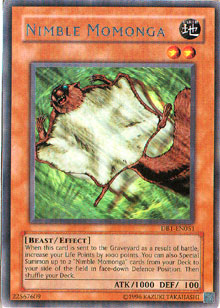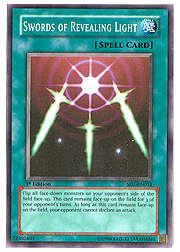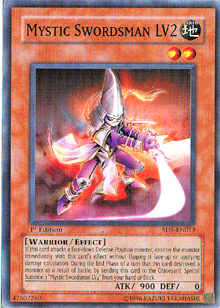 As promised during the preview of Demise, King of Armageddon, I’m back with my second New Grounds column. As you know by now, this series is dedicated to unearthing new strategies from deck types that might otherwise go unnoticed. While I gave a brief rendition of the history of the Ritual archetype, filled with numerous 8-star monsters that packed rather underwhelming effects, I don’t think I stressed enough how weak Ritual decks were prior to the release of Demise.
As promised during the preview of Demise, King of Armageddon, I’m back with my second New Grounds column. As you know by now, this series is dedicated to unearthing new strategies from deck types that might otherwise go unnoticed. While I gave a brief rendition of the history of the Ritual archetype, filled with numerous 8-star monsters that packed rather underwhelming effects, I don’t think I stressed enough how weak Ritual decks were prior to the release of Demise.
The closest to resemble a top-tier deck was the Relinquished/Chaos build in the last format, where multiple copies of Scapegoat and the easy access to Sinister Serpent basically ensured a free cost to bring the monster out onto the field. After all, Manju could search out the Ritual monster or spell and use itself as a tribute cost. The other strength of the deck was its ability to synergize well with Black Luster Soldier – Envoy of the Beginning, one of the most powerful cards of the format. We’ll be using these ideas when constructing our deck today, as it’s centered on one of the strongest monsters in the game.
Demise can take down an entire field by itself. This includes your own monsters and spells or traps, so you have to be very careful when you’re using its effect. In fact, the entire deck must be built in a way to take advantage of the mass destruction that Demise provides. If you have lots of non-chainable traps on the field when Demise’s effect goes off, you certainly won’t be using the card to its full potential. With these basic ideas in mind, let’s get to work on constructing a Ritual deck that can make an impact on the environment!
Monsters: 21
3 Demise, King of Armageddon
3 Manju of the Ten Thousand Hands
1 Sangan
2 Dekoichi the Battlechanted Locomotive
1 Tsukuyomi
2 Magical Merchant
1 Morphing Jar
1 Chaos Sorcerer
1 Breaker the Magical Warrior
1 Magician of Faith
3 Nimble Momonga
2 Spirit Reaper
 Running 21 monsters looks like a lot—why does it work? Most of the key support monsters in this deck are deck thinners. Nimble Momonga will bring two others out from the deck, Magical Merchant will bring at least one, Dekoichi will pull one, and Manju will pull one. You can reasonably expect to have the monster count thinned to about 20 after a few turns, with even more being dumped into play as the duel progresses.
Running 21 monsters looks like a lot—why does it work? Most of the key support monsters in this deck are deck thinners. Nimble Momonga will bring two others out from the deck, Magical Merchant will bring at least one, Dekoichi will pull one, and Manju will pull one. You can reasonably expect to have the monster count thinned to about 20 after a few turns, with even more being dumped into play as the duel progresses.
A heavy monster count is essential for a number of reasons. The first is that we will aim to repeatedly use Pot of Avarice, which essentially nullifies the threat of losing Demise to the graveyard. The second is that an 8-star Ritual monster requires plenty of fodder to dump into the graveyard. And finally, we want monsters for Chaos Sorcerer, since we can then conceivably swarm the board for a total of at least 4700 damage.
Spells: 14
1 Dark Hole
1 Mystical Space Typhoon
1 Heavy Storm
1 Snatch Steal
1 Nobleman of Crossout
1 Scapegoat
1 Swords of Revealing Light
2 Pot of Avarice
2 Enemy Controller
1 Premature Burial
2 End of the World
 The spell lineup is fairly self-explanatory, except for a few noted choices. I generally don’t like using Scapegoat and Swords of Revealing Light in the same deck, but they serve the same purpose here. Both are types of cards that lead to “closed resource” games, where opponents conserve cards in hand for fear of overextending. Good players are reluctant to destroy Swords, since it creates a -1 trade upon finishing up its effect. When Scapegoat tokens hit the field (which can also be used as levels for tributing, by the way), most opponents will not be in a hurry to destroy them. You should always know at the back of your mind that they’ve created an inherent -1 trade, and can be destroyed at leisure.
The spell lineup is fairly self-explanatory, except for a few noted choices. I generally don’t like using Scapegoat and Swords of Revealing Light in the same deck, but they serve the same purpose here. Both are types of cards that lead to “closed resource” games, where opponents conserve cards in hand for fear of overextending. Good players are reluctant to destroy Swords, since it creates a -1 trade upon finishing up its effect. When Scapegoat tokens hit the field (which can also be used as levels for tributing, by the way), most opponents will not be in a hurry to destroy them. You should always know at the back of your mind that they’ve created an inherent -1 trade, and can be destroyed at leisure.
The goal of the deck, of course, is to use this leisure time against your opponent. If you have multiple set monsters on the field and a solid defense, your opponent will often follow suit and begin to set multiples of each card. What he or she doesn’t know, of course, is that many of your set monsters have flip effects that pay for themselves upon resolution. You can then use those monsters as costs for the ritual summon, which allows you to summon Demise and wreak havoc on a board of four or more resources.
Enemy Controller and Pot of Avarice are two nifty choices, as well. Controller is chainable, which is great, and it works against Spirit Reaper, the biggest threat in the game. On the other hand, Pot of Avarice features a number of nifty tricks that can generate card advantage. If the opponent manages to kill off two Nimble Momongas, you can use Avarice to cycle two more back to your deck. Gaining over 4000 life points is always a fun prospect. You can also dump back copies of Demise that were milled off by hand disruption or by your own Merchant effects.
Note the lack of Smashing Ground. Because it’s a 1-for-1 trade that removes your opponent’s invested resource from the field, Smashing Ground is actually counterproductive to the focus of the deck. Yes, I know every main deck features at least two, but thinking outside of the box when you’re building your decks will give you an edge.
Traps: 7
1 Call of the Haunted
1 Torrential Tribute
2 Time Seal
3 Sakuretsu Armor
Your traps are pretty mild-mannered. Remember, you have to be very careful about when to set Sakuretsu Armor. If you create a situation where Sakuretsu is destroyed in the process of using Demise’s effect, you just lost a card. Don’t save your Armors—play them to the hilt and whenever possible to preserve your “floaters.” You want to always use them to either ward off Reaper/Don hits, Tomato crashes into Manju or Dekoichi, and monsters that seek to remove your flip effects from the field. Those 1400 and 1000 pokes from your floaters (which include Manju, Dekoichi, Magical Merchant, and Sangan, among others) will really add up when you hit for around 4000, minimum, on the turn you summon Demise.
Time Seal is a great card that serves two qualities. First, it creates the illusion of defense. Second, it’s chainable at any time. And finally, remember when it will be used. You’re going to be chaining the card upon resolution of an effect that will immediately wipe out at least three of your opponent’s resources. Your opponent will likely have three or fewer cards in hand, and nothing says you love your opponent more than nullifying his or her draw phase after taking a Reaper hit and 2400 life points of damage.
Mechanics of Advantage: The “Good” Ritual Deck
You’re trading Manju (which tutors the Ritual Monster), the Ritual spell, and another card in hand (which provides 4 or more stars) for Demise, King of Armageddon to hit the field. Upon resolving, you will pay 2000 life points to remove (ideally) two of your opponent’s monsters and two of his or her spell or traps from the board. If you’ve been closing the game off correctly, you’ll likely get even more than that.
Upon resolving, you should have the pieces in play to either bring out a Spirit Reaper for an immediate resource hit, or a monster to do some life point damage. It is not entirely uncommon to hit to win the game in a single turn if you have Chaos Sorcerer in hand, a monster to summon, and Premature Burial.
That’s not the half of it. The deck has access to all of the obscenely powerful advantage-creating engines that cookie-cutter decks possess. Yes, you can repeatedly lock your opponent with a flip effect monster, a defensive card, and Tsukuyomi. Yes you can drop Chaos Sorcerer and make your opponent squeal as you get tons of 2-for-1 trades. Yes, Spirit Reaper lurks in the background as you push forth for added damage. Yes, yes, yes: anything is possible with this deck. Do you want to create a 10-for-1 trade after resolution of Morphing Jar? Too bad, I was exaggerating.
Ability to Counter the Metagame
Your opponent says he or she wants to play a Smashing Ground and then attack with Spirit Reaper directly? “Boo hoo,” you should reply.
Dropping Manju in your opening turn is one of the strongest plays possible. If your opponent plays Smashing Ground on it, he or she can say bye-bye to card advantage. If he or she summons Cyber Dragon and Spirit Reaper, there’s no way to tell if you have the pieces for your ritual monster in hand. Upon setting a spell or trap, your opponent has effectively lost three cards. Sure, you’ll use three as well, but the difference is that you have a 2400 ATK monster on the field.
Most traps in this game are unchainable. If your opponent uses multiple copies of Bottomless Trap Hole, you can pound in faces with your army of 1400 ATK monsters. Taking three Dekoichi hits in a row is not fun, as many a player can attest to. In fact, thinking of the advantages generated by this deck just makes me feel warm and bubbly on the inside.
By playing this deck, you turn the metagame’s dependence on Cyber Dragon on its head. The card necessitates overextension to the field. Once the Cyber Dragon player summons two monsters, it’s only a matter of time before two spell or traps will join them. Then, you can drop Demise and squeal like a schoolgirl.
Strategies to Use in a Matchup with a Cookie Cutter Deck
Close, close, close. In this rapid-fire format, it’s often hard to intentionally close down the duel, but that’s your goal! If the field presence allows it (having a Reaper, Sheep tokens, or a set monster on the field) you’ll always want to summon Manju and dig out a copy of Demise. The reason for this is that it can always pay the ritual cost of the spell, and that Magical Merchant can dig out copies of the spell card.
When field presence is secure, meaning you can’t take a discard from a Smashing Ground or Crossout next turn (due to a Reaper hit), your priority should be a Manju summon, then a flip effect set, and finally a Reaper set. Your traps and Reapers will be the main way of maintaining field presence, so keep that in mind.
 Your defensive strategy will be difficult to pierce through, since most cookie-cutter decks don’t have many effective means of pushing through face down monsters. Mystic Swordsman LV2 is a problem, of course, but there’s only one copy of it and you can simply summon Manju and use that as a floater to smack the pesky card around.
Your defensive strategy will be difficult to pierce through, since most cookie-cutter decks don’t have many effective means of pushing through face down monsters. Mystic Swordsman LV2 is a problem, of course, but there’s only one copy of it and you can simply summon Manju and use that as a floater to smack the pesky card around.
As the duel progresses, you and your opponent should have an equal amount of resources. The difference is that most of his or hers will be on the field, with about a two-to three-card hand size, while most of yours will be in hand, with about two of your cards on the field at any given time.
The general conditions for unloading Demise are: you have Spirit Reaper in hand, you have Premature Burial in hand, or you have Chaos Sorcerer in hand. The first generates automatic advantage regardless of whether the opponent has Bottomless Trap Hole, Torrential Tribute, or even Scapegoat handy. The chain works with Demise’s effect placed first, and Scapegoat stacking on top. Because Scapegoat puts the tokens on the field upon resolution, Demise’s effect will wipe them clear.
That means Demise guarantees hand disruption with Reaper, short of Waboku or Threatening Roar, which are 1-for-0 trades in your favor anyway. Also remember that cards like Premature Burial stack damage onto the equation, so you can feel free to use Premature Burial on your Sangan to do 1000 extra points of damage to your opponent.
Provided the right draws and assuming you can manage the tempo of the game, you should win. Remember, if you take one Reaper hit, you’ll drastically lower your chances to win. Take more than one, and you’re virtually guaranteed a loss. Combo-oriented decks suffer much more from hand disruption than standard cookie-cutter decks do, so be careful.
The New Grounds Verdict: Ritual Decks are Here to Stay!